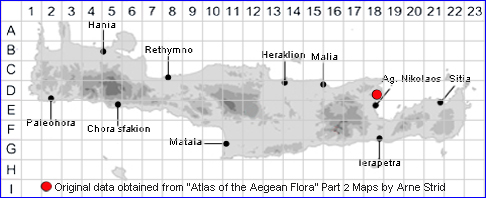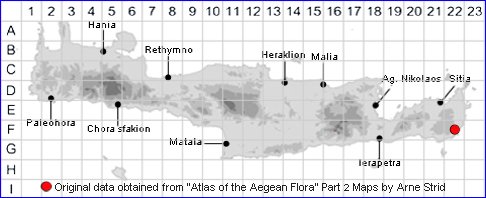

SPECIES DESCRIPTION
LIMONIUM RORIDUM
Including:
Family:- PLUMBAGINACEAE
Common Names:- Greek sea-lavender
Synonyms:- Limonium graecum, Limonium hyssopifolium, Statice echioides,
Statice hyssopifolia, Statice tournefortii.
Meaning:- Limonium (Gr) Meadow-plant. A name used by the Greek physician
and botanist Dioscorides.
Roridum (L) Apparently with a minutely blistered surface, bedewed.
General description:- Glabrous, perennial, forming a sub-shrub 10-35 cm tall, with
many erect stems and a robust tap-root.
Caudices:-
1) 2-15 cm long.
2) Densely branched and densely spirally leafy in the upper half.
3) Sometimes leaves in rosettes at the apices.
Stems:-
1) 7-30 cm long.
2) Tuberculate with many crateriform glands.
3) Glaucous, conspicuously flexuous. much branched.
4) Sterile branches numerous, 0.5-5.0 cm long.
5) Fertile branches
a) numerous, glaucous.
b) tuberculate with many crateriform glands.
c) 1-6 cm long.
Leaves:-
1) Fleshy, rigid, glaucous, tuberculate with many crateriform glands.
2) 10-30 mm long x 4-8 mm broad.
3) Spathulate, apex obtuse.
4) Often v-shaped in cross-section.
5) Gradually tapering into the petiole.
Flowers:-
1) Spikes 10-50 mm long, arched, inserted erect to obliquely.
2) Spikelets 7.2-9.5 mm long, composed of 1-5 flowers.
3) Outer bract 2.2-3.0 mm long x 2.2-2.6 mm broad, triangular-ovate, obtuse to
rounded.
4) Middle bract membranous, 2.7-3.1 mm long x 2.0-2.5 mm broad, elliptic to
oblong-elliptic.
5) Inner bract 6.3-7.3 mm long x 4.2-5.0 mm broad, oblong-obovate, rounded
6) Calyx 6-7 mm long, exceeding the inner bract by 1-2 mm.
a) calyx tube sparsely to densely more or less long hairy.
b) calyx lobes very fine, ca. 0.5 x 1.1 mm, semi-circular.
7) Corolla pink to lilac.
Habitat:- Rocky coasts, mainly on hard limestone, occasionally in maritime sand
or rocky slopes with dry open shrubby vegetation up to 300 m.
Distribution:- Frequent in the central and southern Aegean region: also occurs in
western Turkey. Fairly common around the coastal areas of Crete.
Flowering time:- Apr-July, occasionally later.
Photos by:- Andriy Kovalchuk
FAMILY AND GENUS DESCRIPTIONS
PLUMBAGINACEAE
General description:- Herbs or shrubs.
Leaves:- Alternate or in basal rosettes, exstipulate.
Flowers:- Inflorescence usually cymose, often contracted into a capitulum, rarely
spike-like. Flowers actinomorphic, 5-merous, usually in bracteate spikelets. Calyx
tubular below, toothed (dentate) or lobed and at least slightly thin and dry (scarious)
and often pleated (plicate) distally, persistent. Petals united (connate) only at the
base, or the corolla with a usually short tube. Stamens united with the petals
(epipetalous). Styles 5, or 1 with 5 stigma-lobes. Ovary superior, 1-locular.
Fruit:- Dry, membranous, 1-seeded, surrounded by calyx, not splitting open to
release their seeds (indehiscent) or with circumscissile or irregular dehiscence.
LIMONIUM
General description:- Perennial, rarely annual, herbs or dwarf shrubs.
Leaves:- Simple, usually in a basal rosette, but densely leafy branches sometimes
present; leaves often absent at anthesis.
Flowers:- Inflorescence a corymbose panicle, with terminal, secund spikes, often
with non-flowering branches, usually with a reddish scale at the base of each
branch. Spikes of 3-bracteate, 1- to 5-flowered spikelets; inner and outer bracts
external to the spikelet, the middle one internal and often inconspicuous. Calyx
funnel-shaped (infundibuliform); limb thin and dry (scarious), usually coloured,
sometimes shortly dentate between the lobes. Corolla with a short tube, or the
petals united (connate) only at the base. Stamens inserted at the base of the
corolla. Styles 5, glabrous, free or connate at the base; stigmas thread-like
(filiform).
Fruit:- With circumscissile (opening by a slit running around the circumference) or
irregular splitting open to release the seeds (dehiscence).
1) Calyx infundibuliform.
2) Stamens inserted in base of corolla.
3) Styles 5, free or connate in basal half.
4) Fruit circumscissile towards apex or with irregular dehiscence.
5) Corolla-tube much shorter than lobes.
6) Spikes secund, the terminal not distinctly larger.
7) Stigmas filiform.

LIMONIUM AMMOPHILON
Synonyms:- Limonium graecum subsp. ammophilon
Meaning:- Ammophilon (Gr) Sand-loving.
Resembling Limonium roridum, but differering in the following characters.
1) Inner bracts longer, rugose.
2) Outer and middle bracts.very hairy
Click here for a more detailed description of this species.
Habitat:- Rocky coasts of various substrates, sandy places. 0-10 m.
Distribution:- Endemic to Greece and not recorded outside the Aegean area. Rare on Crete, currently known from only two locations
Flowering time:- Mid May to August, occasionally later.
Photos currently unavailable.
Synonyms:- Limonium graecum subsp. ammophilon
Meaning:- Ammophilon (Gr) Sand-loving.
Resembling Limonium roridum, but differering in the following characters.
1) Inner bracts longer, rugose.
2) Outer and middle bracts.very hairy
Click here for a more detailed description of this species.
Habitat:- Rocky coasts of various substrates, sandy places. 0-10 m.
Distribution:- Endemic to Greece and not recorded outside the Aegean area. Rare on Crete, currently known from only two locations
Flowering time:- Mid May to August, occasionally later.
Photos currently unavailable.
LIMONIUM FRAGILE
Synonyms:- None
Meaning:- Fragile (L) Fleeting, brittle, fragile.
Resembling Limonium roridum,, but differering in the following characters
1) The slightly more erect branches and somewhat smaller spikelets and flowers
Click here for a more detailed description of this species.
A dubious species with no clear morphological differences with respect to L. roridum and with the same chromosome number (2n = 43).1)
1) "Atlas of the Aegean Flora" Book1, Arne Strid 2016.
Habitat:- Rocky coastal habitats, on limestone.
Distribution:- Presumably endemic to the Aegean area. Very rare on Crete currently recorded from one area.
Flowering time:- May-August.
Photos currently unavailable.
Synonyms:- None
Meaning:- Fragile (L) Fleeting, brittle, fragile.
Resembling Limonium roridum,, but differering in the following characters
1) The slightly more erect branches and somewhat smaller spikelets and flowers
Click here for a more detailed description of this species.
A dubious species with no clear morphological differences with respect to L. roridum and with the same chromosome number (2n = 43).1)
1) "Atlas of the Aegean Flora" Book1, Arne Strid 2016.
Habitat:- Rocky coastal habitats, on limestone.
Distribution:- Presumably endemic to the Aegean area. Very rare on Crete currently recorded from one area.
Flowering time:- May-August.
Photos currently unavailable.

LIMONIUM XEROCAMPOSICUM
Synonyms:- None
Meaning:- Xerocamposicum (L) Named after Xerocampos in eastern Crete, where it was collected.
Resembling Limonium roridum,, but differering in the following characters
1) Being somewhat smaller in all parts, with narrower leaves and fewer sterile branches.
Click here for a more detailed description of this species.
A dubious species known only from the type collection. It is likely to represent a depauperate form of L. roridum, modified to the hot and dry climate of SE Crete. 1)
1) "Atlas of the Aegean Flora" Book1, Arne Strid 2016.
Habitat:- Rocky, calcareous coastal habitat.
Distribution:- Cretan endemic. Very rare known only from the type location.
Flowering time:- In August.
Photos currently unavailable.
Synonyms:- None
Meaning:- Xerocamposicum (L) Named after Xerocampos in eastern Crete, where it was collected.
Resembling Limonium roridum,, but differering in the following characters
1) Being somewhat smaller in all parts, with narrower leaves and fewer sterile branches.
Click here for a more detailed description of this species.
A dubious species known only from the type collection. It is likely to represent a depauperate form of L. roridum, modified to the hot and dry climate of SE Crete. 1)
1) "Atlas of the Aegean Flora" Book1, Arne Strid 2016.
Habitat:- Rocky, calcareous coastal habitat.
Distribution:- Cretan endemic. Very rare known only from the type location.
Flowering time:- In August.
Photos currently unavailable.
